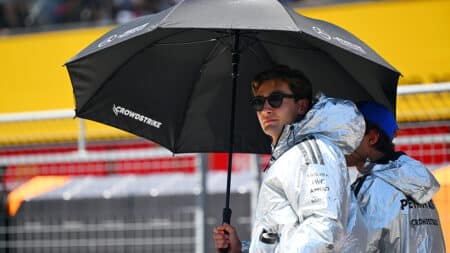
2025 is F1’s most polite title battle ever – Up/Down in Austria
Describing this year's championship race as a 'battle' might be slightly over-egging it, writes James Elson
 When it comes to trying something new, uncovering the latest trick, getting an edge on the opposition, there are few examples in Formula 1 as visually striking and obviously unusual as the year Tyrrell decided to add two more wheels to its Grand Prix cars. As the February edition of Motor Sport celebrates, innovation is at the heart of F1 – it always has been, it always will be. And Tyrrell was brave enough to stick its neck out and run the risk of ridicule. That the P34 six-wheeler became a GP winner vindicated Derek Gardner’s decision to aggressively chase the ‘unfair advantage’.
When it comes to trying something new, uncovering the latest trick, getting an edge on the opposition, there are few examples in Formula 1 as visually striking and obviously unusual as the year Tyrrell decided to add two more wheels to its Grand Prix cars. As the February edition of Motor Sport celebrates, innovation is at the heart of F1 – it always has been, it always will be. And Tyrrell was brave enough to stick its neck out and run the risk of ridicule. That the P34 six-wheeler became a GP winner vindicated Derek Gardner’s decision to aggressively chase the ‘unfair advantage’.
The car that appears on our front cover this month is a museum piece from the Donington Collection. It’s Patrick Depailler’s car just as he left it at the end of 1977, and our man Andrew Frankel was lucky enough to get the chance to drive it. Meanwhile, editor-in-chief Nigel Roebuck revisits a period interview with Gardner and looks back at the shockwaves the P34 created when it was unveiled in ’76. As is often the case in Motor Sport, it’s a story of what might have been because, even though Jody Scheckter won the Swedish GP in its first season, the car never fulfilled the potential Gardner saw in it. Both March and Williams experimented with two extra wheels at the back, but six-wheeled F1 cars proved to be a cul de sac rather than the road to the future. Such is the way with innovation. Even when it works it doesn’t always stick. And when it does it’s usually banned.
That is certainly true in today’s F1, as former Renault technical director Pat Symonds discusses in his first feature for Motor Sport. We’re delighted to welcome him to our pages because, as you might have noticed in our recent audio podcast with the man, he is brilliant at explaining the complexities of our sport. A restrictive rule book stymies the modern designer, but forward thinking still allows them to gain an edge – as McLaren’s F-duct proved last season. And like all great innovations, it is now outlawed. Nothing really changes.
The theme of innovation in the February issue focused our minds on the big breakthroughs in history. I asked former editor Paul Fearnley to look back at some of the ‘epoch’ moments from the past, which was a gigantic task. His vast research distilled to a clear conclusion: the 1970s and early ’80s – the ‘analogue’ era – was an intense time for experimentation and high-reaching concepts. It was a time that directly shaped today’s ‘digital’ age, which is why Paul talked to five men – Tony Southgate, Robin Herd, John Barnard, Gordon Murray and Peter Wright – who all pushed the boundaries of what could be achieved.
Our snapshot of 40 years of F1 innovation is completed by Nick Wirth, who argues the case for designing an F1 car purely by computer. Like Gardner back in the mid-70s, he is putting his reputation on the line by bucking the trend with what he is trying to achieve at Marussia Virgin Racing. Grand thinking and ambitious pioneers – whether they fail or succeed – still give F1 its edge in the modern age.
It’s fitting that in an issue that is themed around innovative thinking one of the great racing car designers should join our team. Williams co-founder Patrick Head has signed up as our new columnist for the next 12 months, and is sure to bring us great tales from the past, as well as personal insight into life in F1 today. We’re delighted to welcome him on board.
The February issue also marks the 10th anniversary of Dale Earnhardt’s passing, US editor Gordon Kirby putting into true perspective the giant legacy of NASCAR’s Man in Black. Meanwhile, Simon Taylor travels to Spain to meet John Webb for lunch. For 30 years the man who ran Brands Hatch was perhaps the most influential, forward-thinking figure in British motor sport. In his own way, Webb was as innovative as the great designers who shaped the races he promoted.
A happy new year to you. Enjoy the issue.

Describing this year's championship race as a 'battle' might be slightly over-egging it, writes James Elson

You had to read between the lines at the 2025 Austrian Grand Prix as George Russell dropped hints over about his dissatisfaction, and F1 sent a message to FIA president Mohammed Ben Sulayem

From zero to hero: in a pacy McLaren, at one of his favourite F1 circuits, Lando Norris picked himself up from a disastrous Canadian race to reign supreme in the 2025 Austrian Grand Prix

Full F1 schedule for the year, including the next F1 race of 2025: the British Grand Prix at Silverstone, the whole calendar and circuit guides for the 24-race Formula 1 season